The Communist Party
Fascism encountered generalised resistance in the Julian March that was based above all on national impulses. Resistance was spontaneous and organised, and even armed, the only such case in Europe at that time.
The Communist Party of Italy (PCd’I) was founded in January 1921, and Slovene communists from the Julian March were among those who joined it. Its watchwords were revolution and social emancipation. Outlawed by Mussolini in 1926, the Party continued to operate clandestinely. Its leadership was based in Paris and maintained contact with the territory by means of emissaries. The organisation was constantly having to renew itself, since multiple mass arrests crippled its activity.
The policies of the Communist Party underwent modifications with regard to two issues: the national problem and collaboration with members of the TIGR organisation. To begin with, the Party denied the existence of a national question, but in April 1934, following the signing of a joint declaration by the Communist Parties of Italy, Austria and Yugoslavia, it recognised the minority’s right to self-determination and secession. Meanwhile, it refused entirely to collaborate with the members of TIGR because of the terrorist methods they employed and their ties to the Kingdom of Yugoslavia. In December 1935, however, it signed an agreement with them. This resulted in the establishment of a broad popular front whose principal task was the fight against Nazism and Fascism.
A new phase in the Communist movement began in 1937 when Pinko Tomažič returned from emigration. Together with Alojz Budin, he established the provincial leadership and extended the Party’s organisational network to Tolmin and Postojna. Links were forged with the Communist Party of Slovenia. The Communists prepared themselves for an armed uprising, which was seen as the only way to bring about the unification of the Slovenes in the event of a conflict between Italy and Yugoslavia.
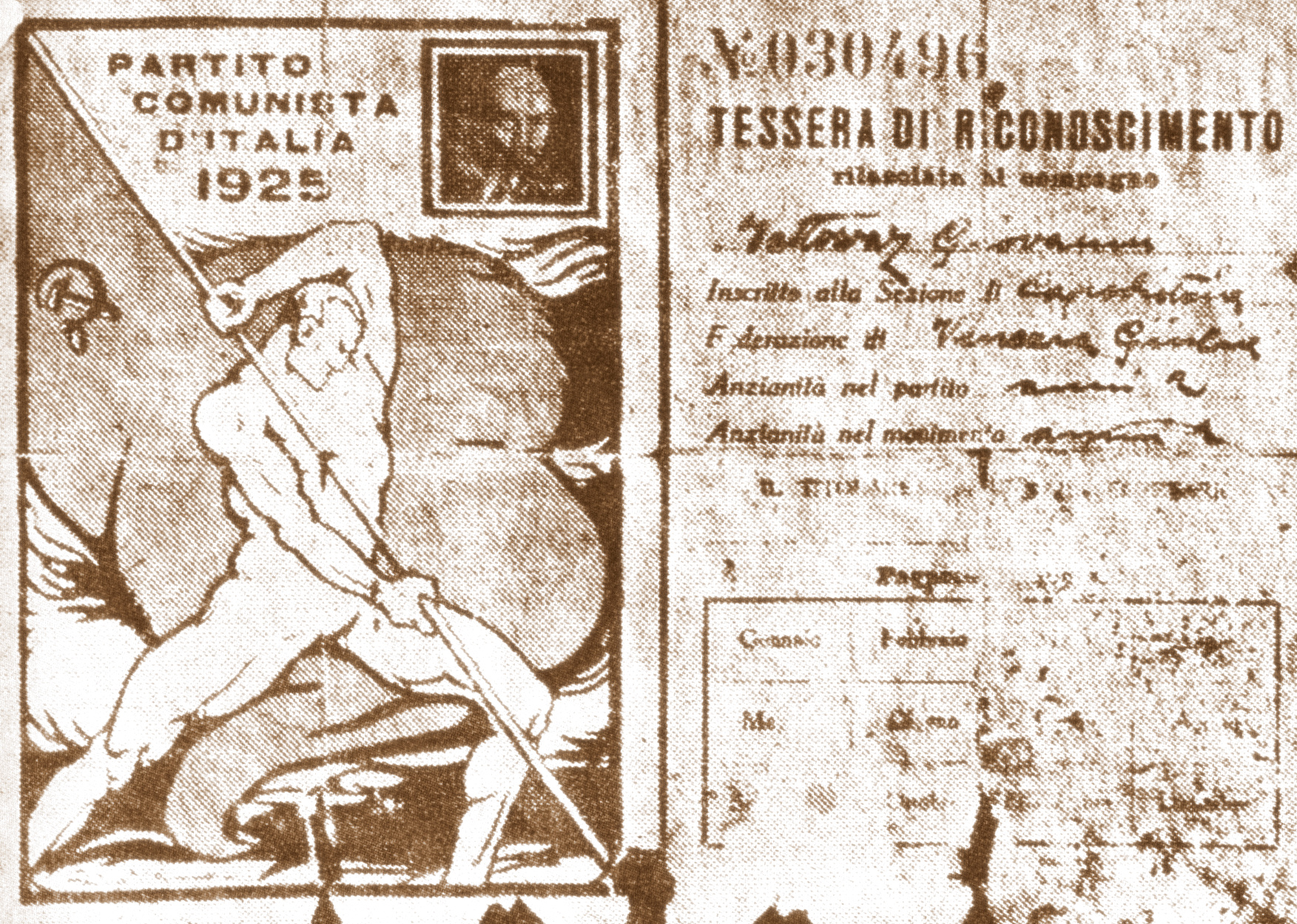 Membership card from 1925.
Membership card from 1925.
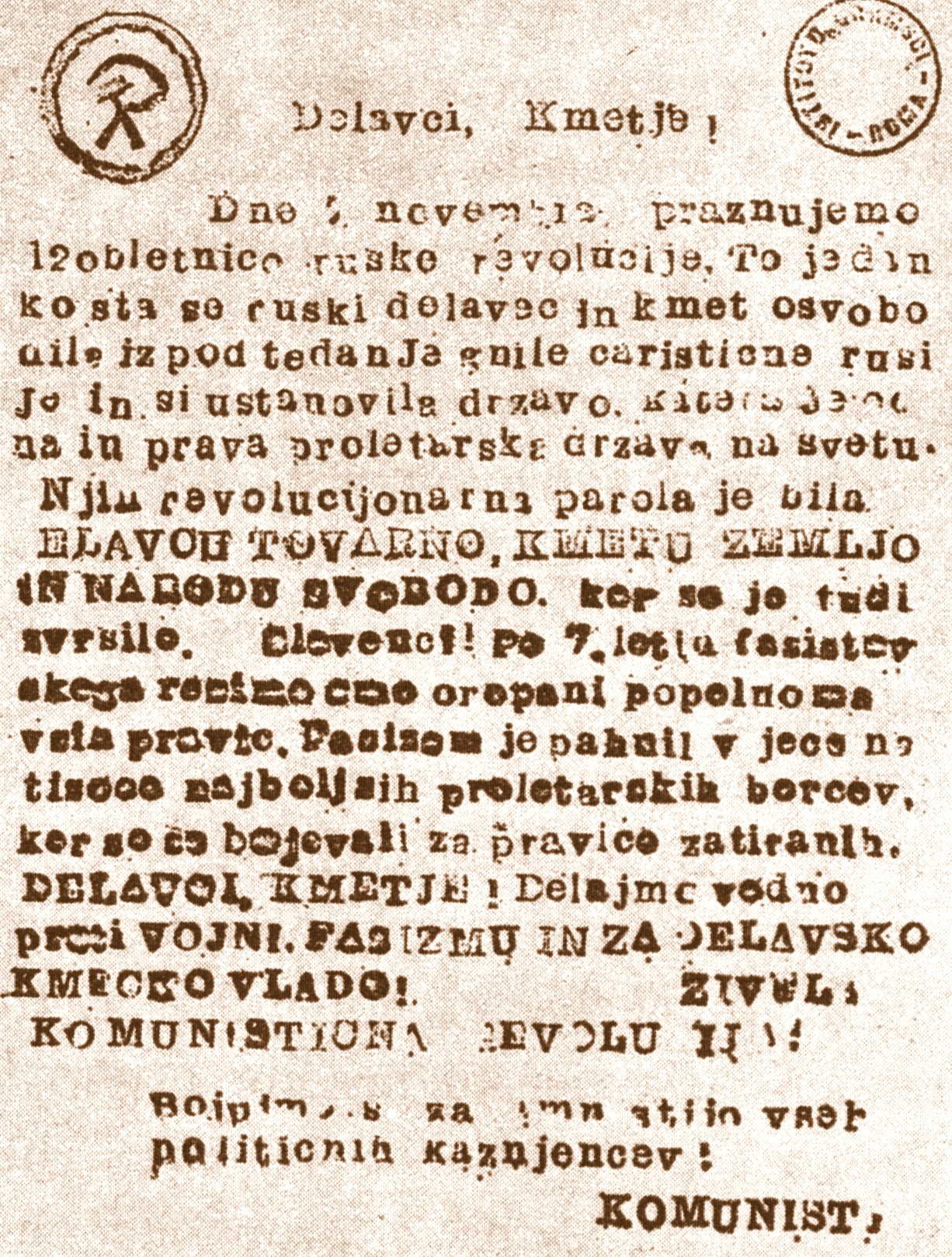
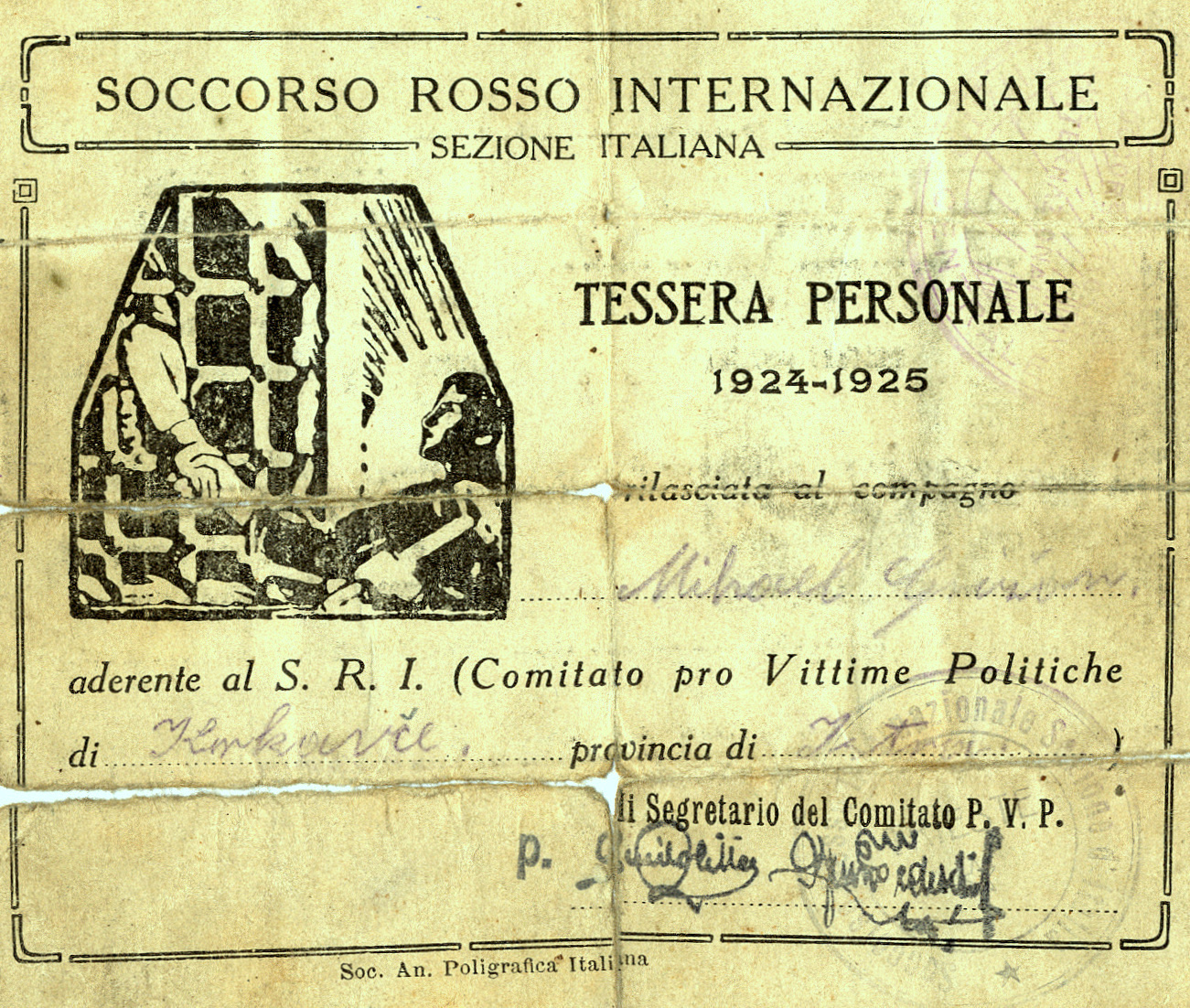 International Red Aid membership card. The organisation provided assistance to the families of those subjected to persecution.
International Red Aid membership card. The organisation provided assistance to the families of those subjected to persecution.
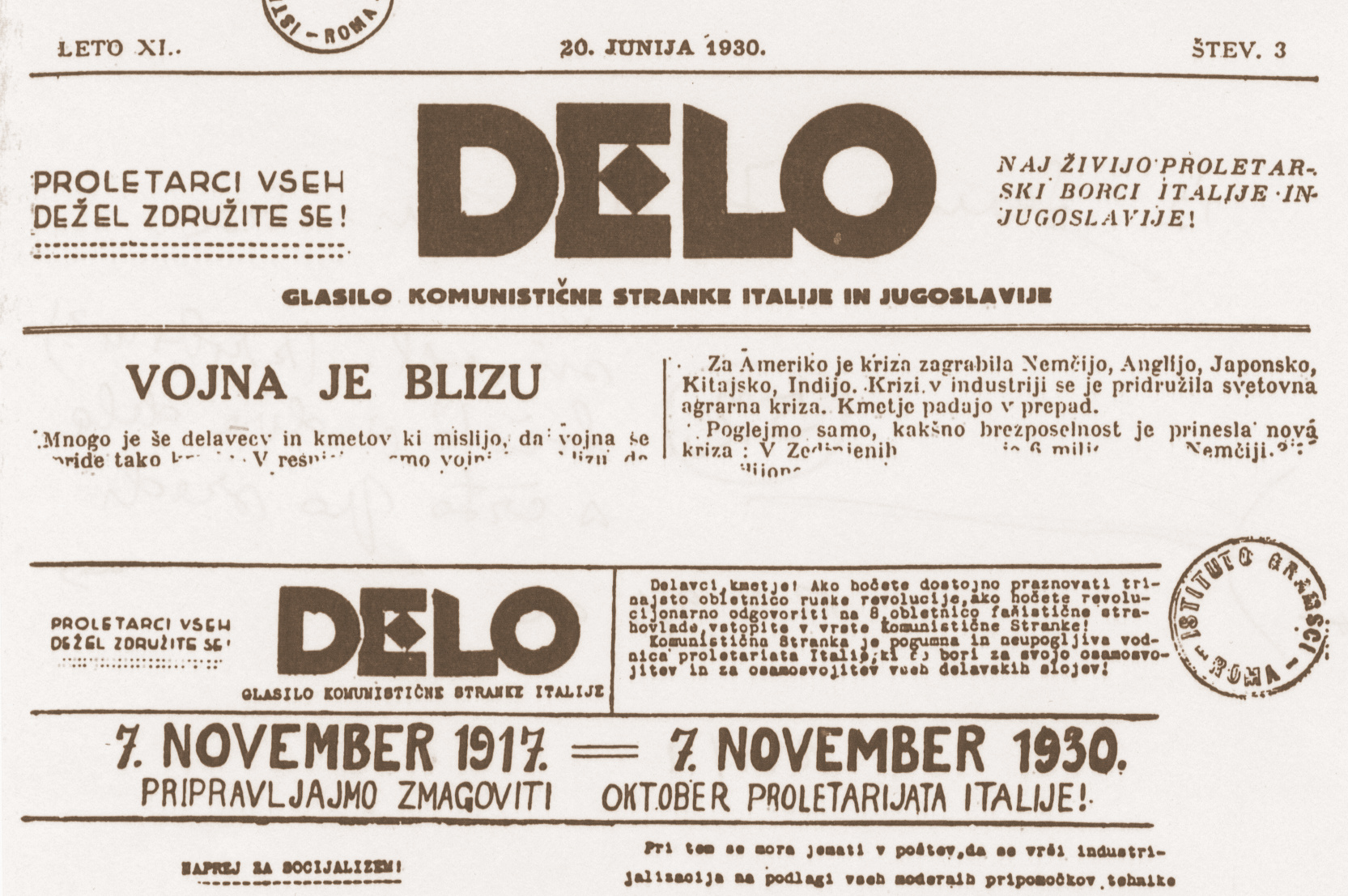 Delo – the Slovene newspaper of the Communist Party in the Julian March. It was published from 1921 until 1926, when the party was abolished. After 1926 it was published clandestinely, initially in the Gorizia region and then outside the country as a joint organ of the Italian Communist Party and the Yugoslav Communist Party. In the 1930s a local edition of Delo was also published.
Delo – the Slovene newspaper of the Communist Party in the Julian March. It was published from 1921 until 1926, when the party was abolished. After 1926 it was published clandestinely, initially in the Gorizia region and then outside the country as a joint organ of the Italian Communist Party and the Yugoslav Communist Party. In the 1930s a local edition of Delo was also published.
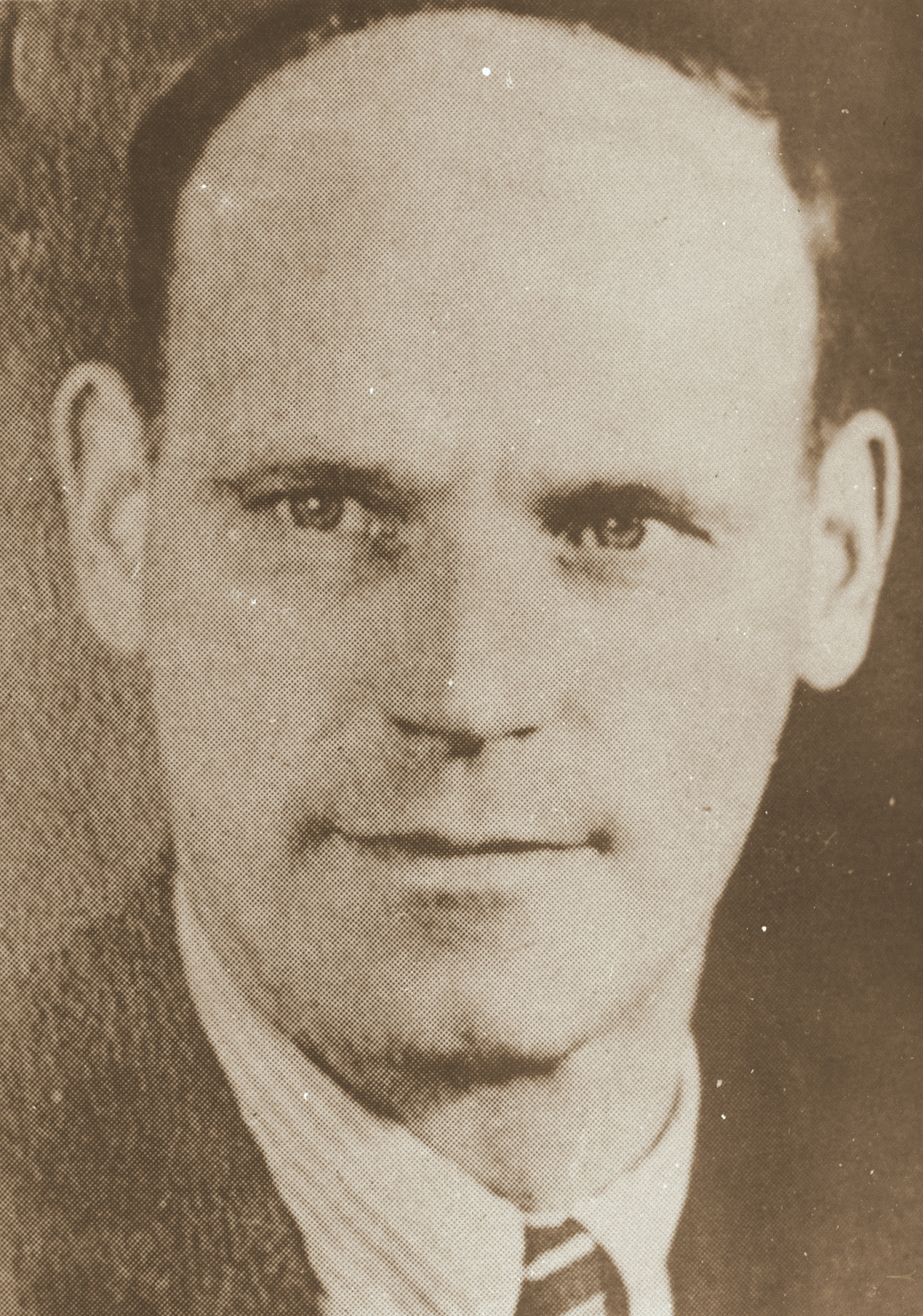 Natale Kolarič, emissary of the central committee of the PCd’I. Born in Sveta Barbara in 1908. In the early 1930s he organised the Party network in Slovene Istria and extended it to Ilirska Bistrica and the Gorizia area. In 1933 he was sentenced to 12 years’ imprisonment. In September 1944 he was shot as a hostage by the Germans.
Natale Kolarič, emissary of the central committee of the PCd’I. Born in Sveta Barbara in 1908. In the early 1930s he organised the Party network in Slovene Istria and extended it to Ilirska Bistrica and the Gorizia area. In 1933 he was sentenced to 12 years’ imprisonment. In September 1944 he was shot as a hostage by the Germans.
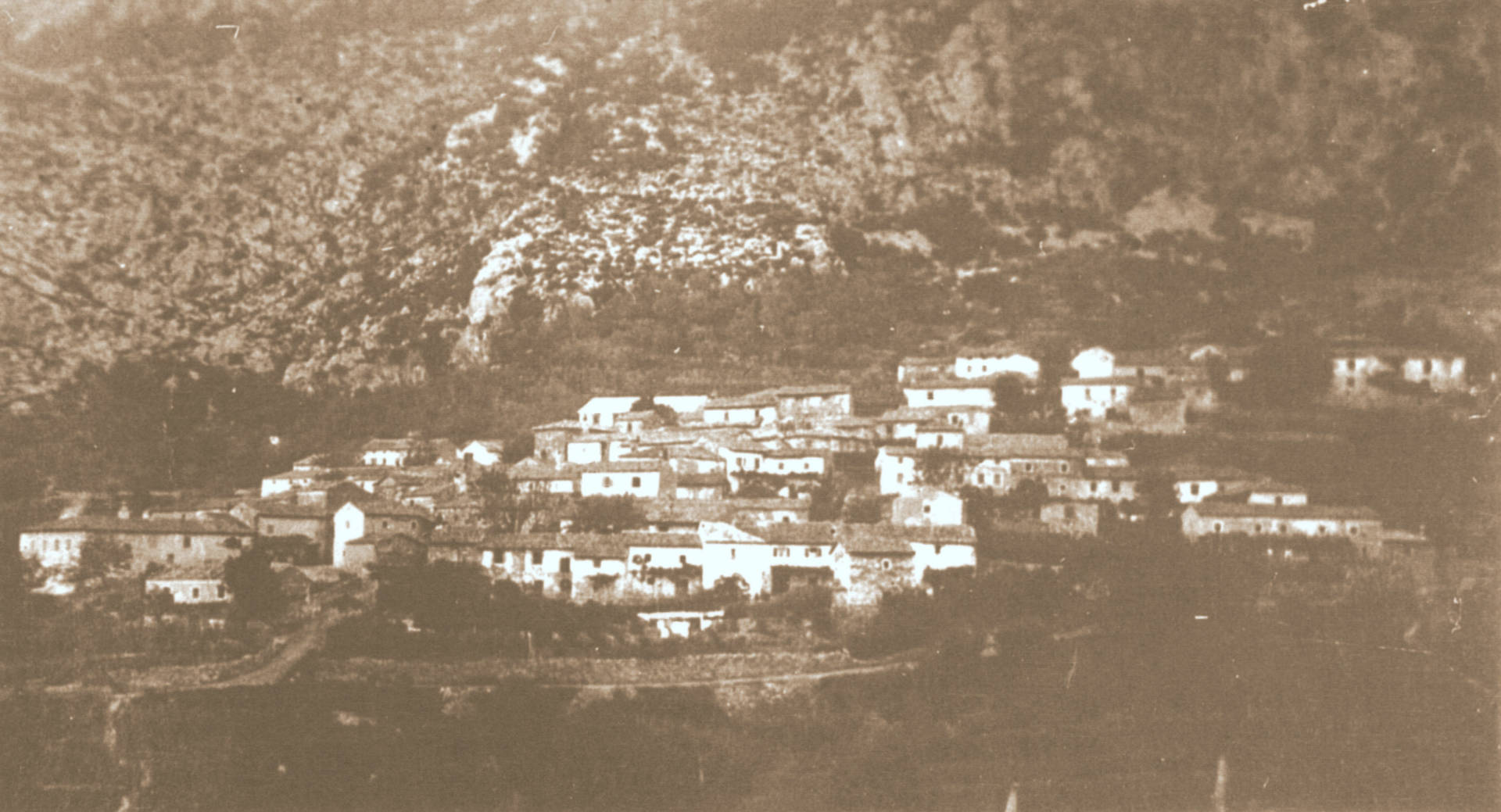 Old Gabrovica before the First World War. A centre of the antifascist movement in the interwar period, this little village became a kind of Partisan capital during the war, until it was burnt down in May 1944. It was here, in 1932, that the Communists led by Kolarič set up a clandestine printing shop known as Žena (“Woman”), which used a cyclostyle machine to print one edition of the newspaper Kmetski glas.
Old Gabrovica before the First World War. A centre of the antifascist movement in the interwar period, this little village became a kind of Partisan capital during the war, until it was burnt down in May 1944. It was here, in 1932, that the Communists led by Kolarič set up a clandestine printing shop known as Žena (“Woman”), which used a cyclostyle machine to print one edition of the newspaper Kmetski glas.
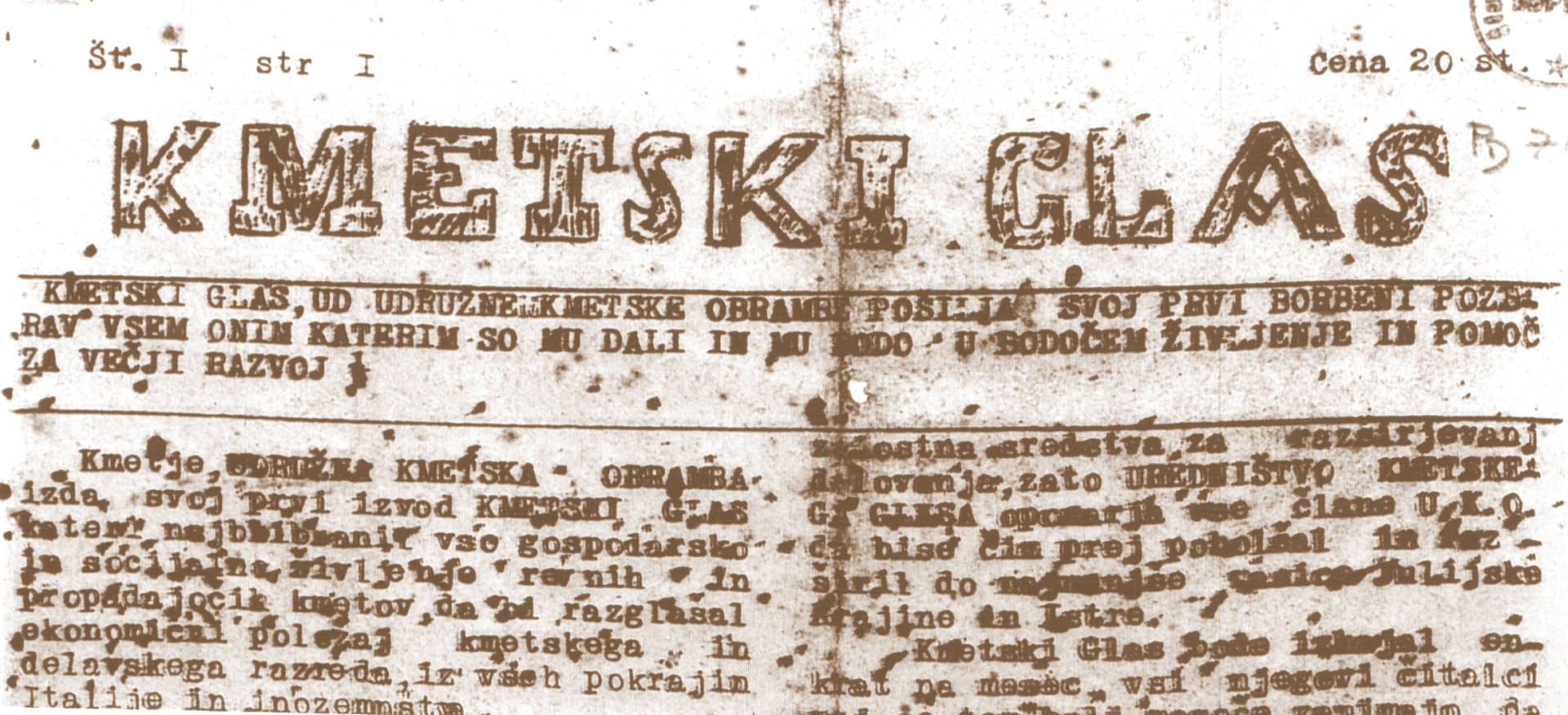 Kmetski glas, organ of the United Rural Defence. This interesting Communist publication in the Slovene language wrote from a class perspective about the organisation of farmers in connection with the proletariat and about the struggle for social and national rights.
Kmetski glas, organ of the United Rural Defence. This interesting Communist publication in the Slovene language wrote from a class perspective about the organisation of farmers in connection with the proletariat and about the struggle for social and national rights.
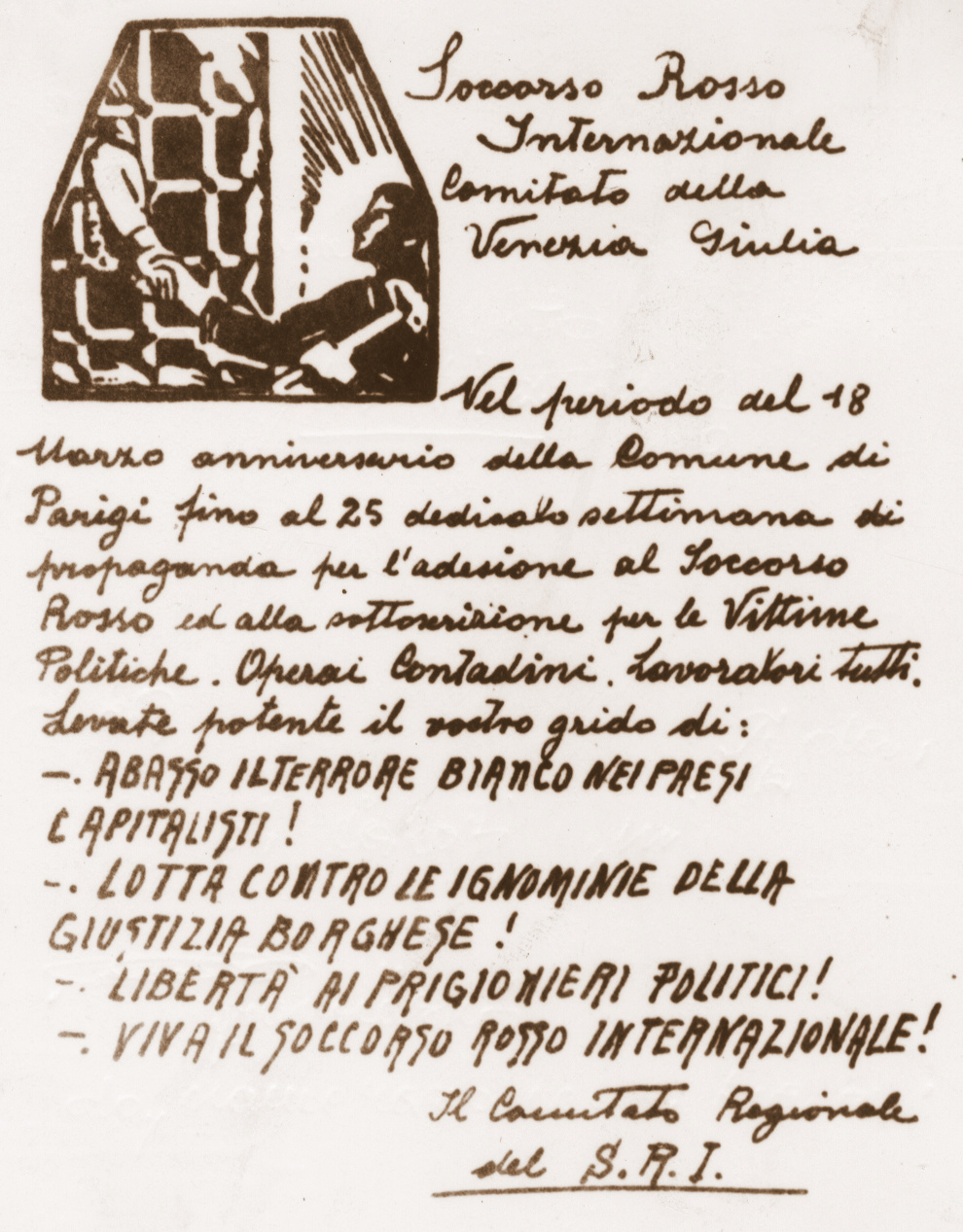 Flyer of the Italian section of International Red Aid.
Flyer of the Italian section of International Red Aid.
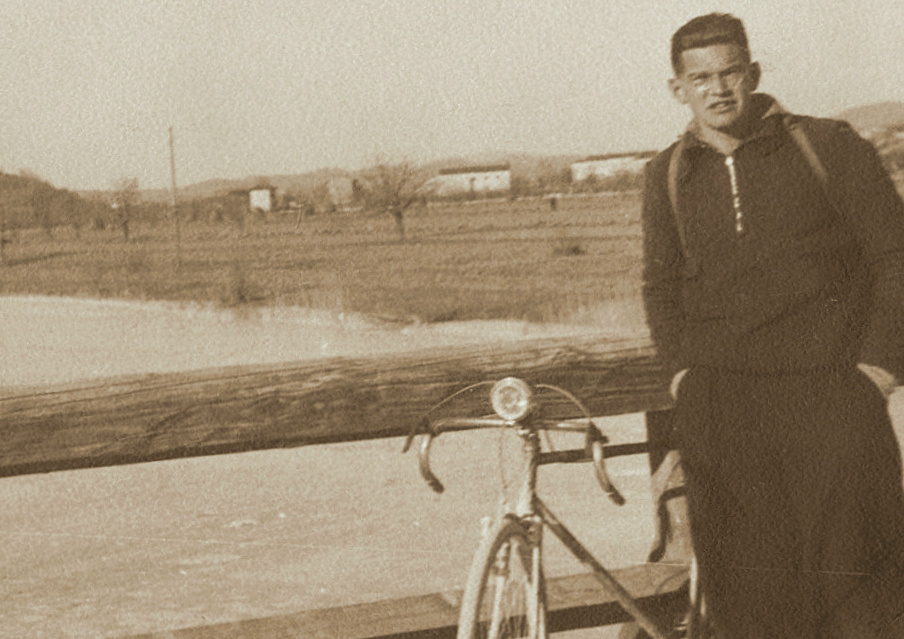 Pinko Tomažič, organiser and leading figure of the Communist movement in the years 1937–1940.
Pinko Tomažič, organiser and leading figure of the Communist movement in the years 1937–1940.
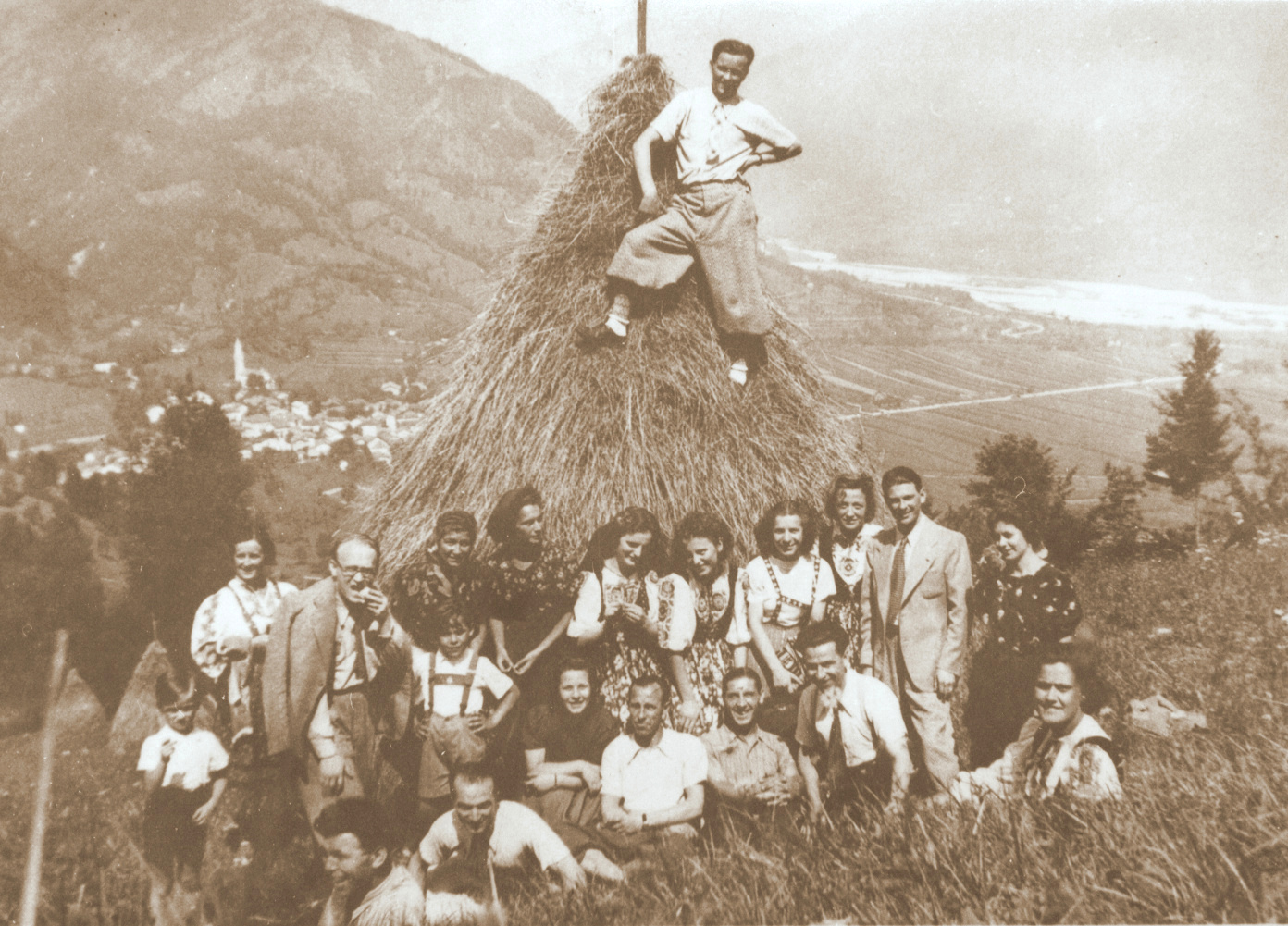 A group of young people on Mt Trstelj in 1937. Tomažič is among them.
A group of young people on Mt Trstelj in 1937. Tomažič is among them.
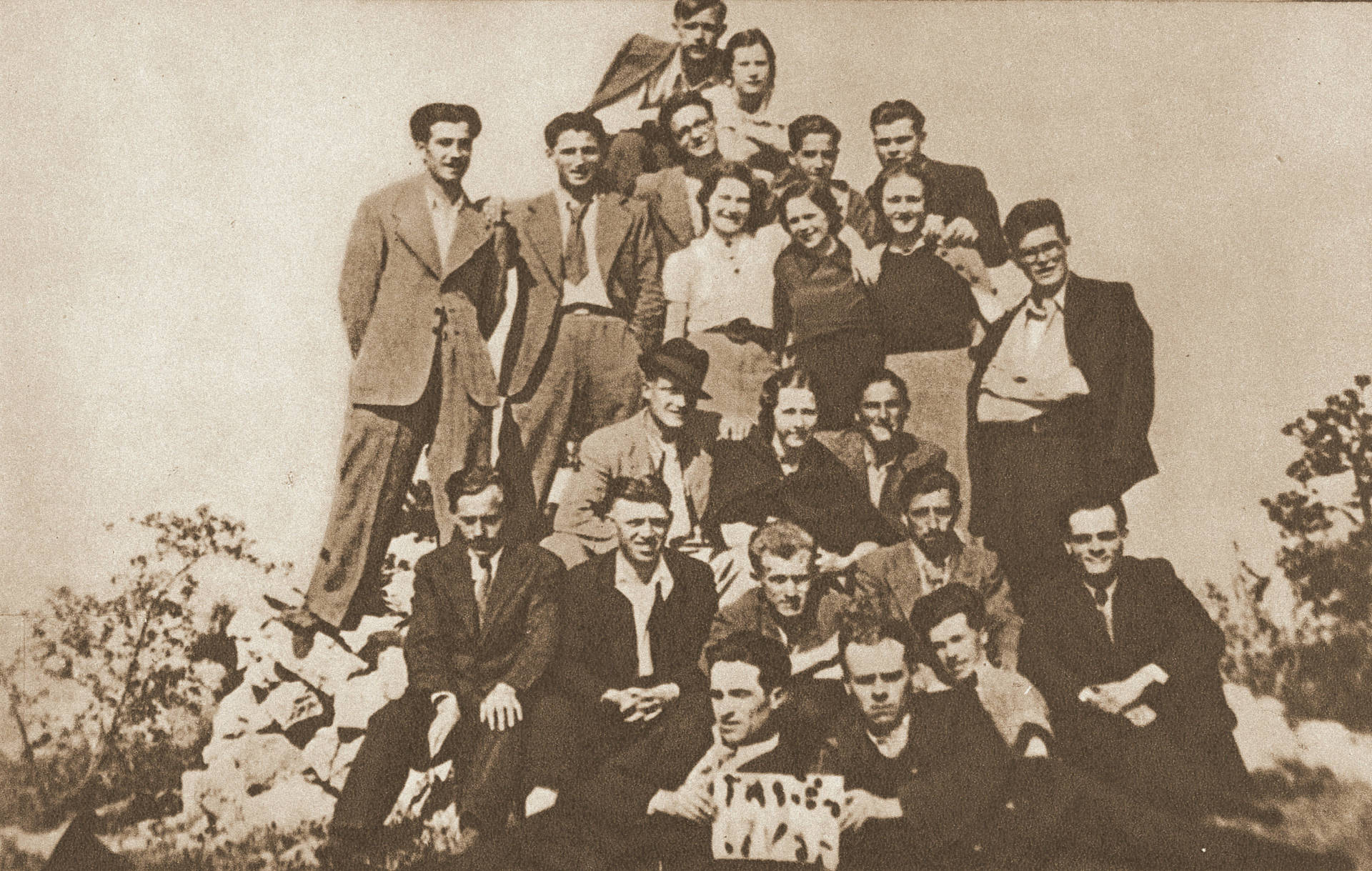 Youngsters from Trieste, members of the San Giacomo choral society, on an excursion along the Soča in 1938.
Youngsters from Trieste, members of the San Giacomo choral society, on an excursion along the Soča in 1938.
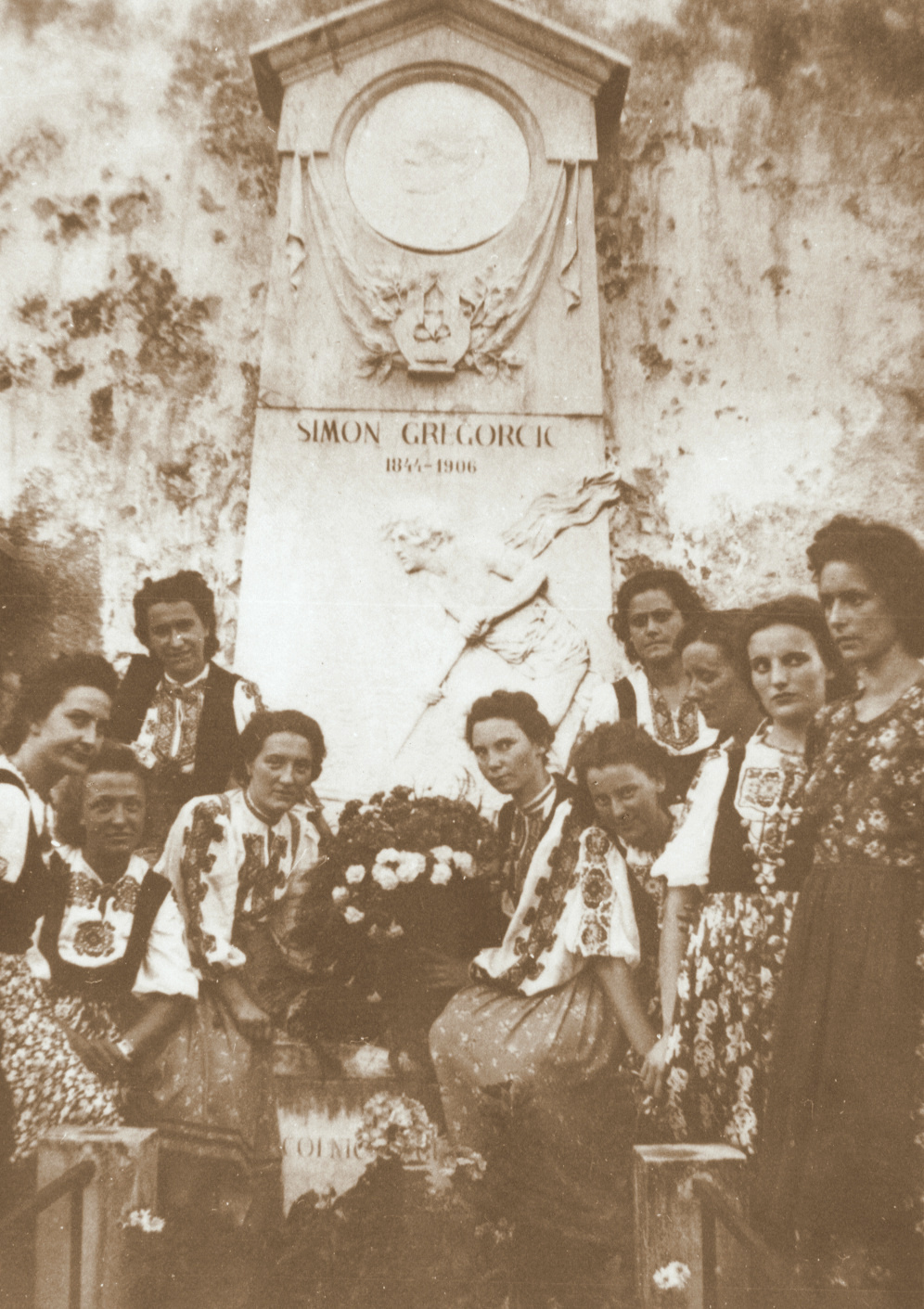 Youngsters from Trieste, members of the San Giacomo choral society, on an excursion along the Soča in 1938.
Youngsters from Trieste, members of the San Giacomo choral society, on an excursion along the Soča in 1938.
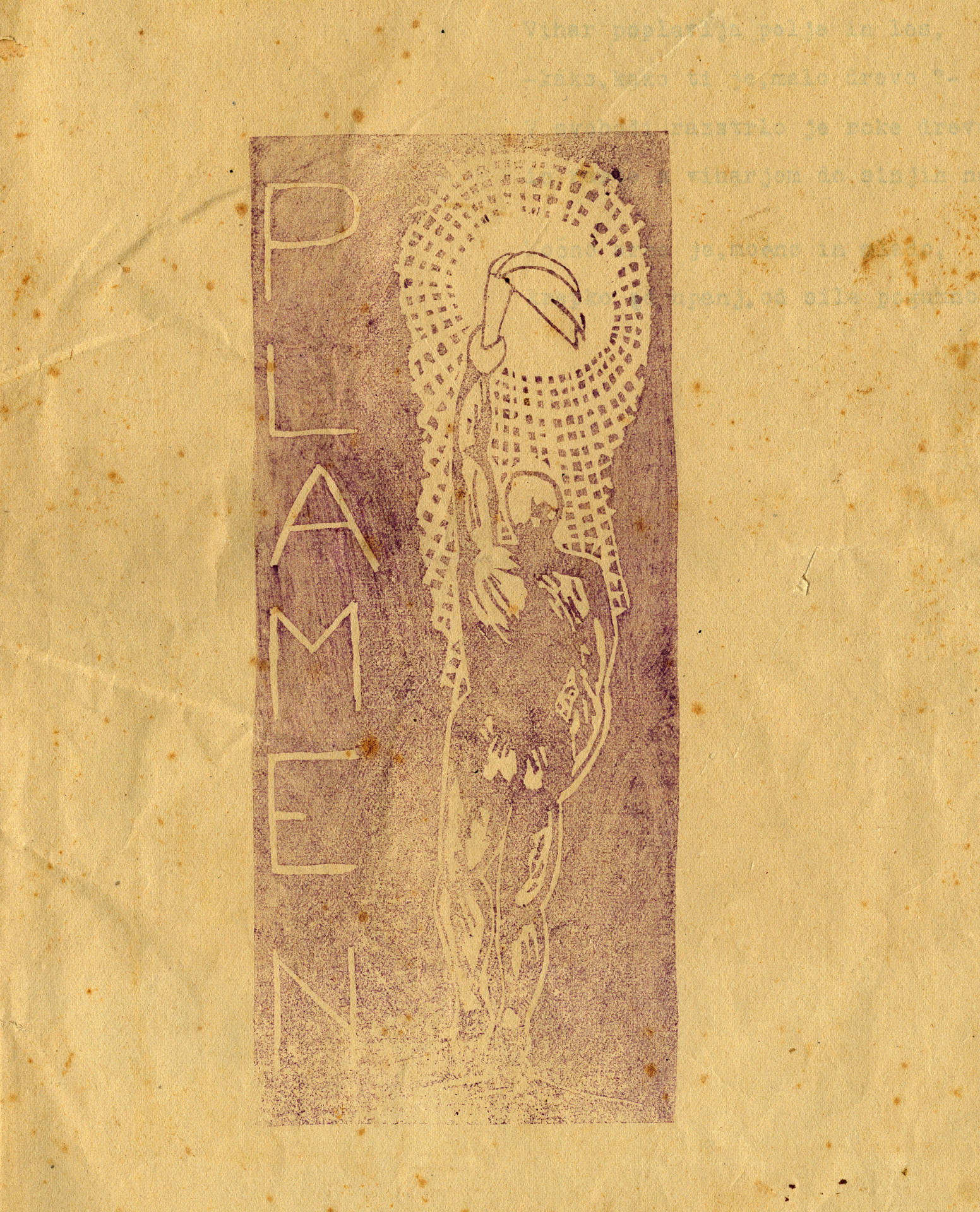 Plamen (“Flame”) – clandestine publication of young Slovenes in Trieste.
Plamen (“Flame”) – clandestine publication of young Slovenes in Trieste.
Organisations
TIGR
TIGR (standing for Trieste, Gorizia, Istria and Rijeka) was a national revolutionary youth organisation of a liberal and Catholic orientation and an irredentist philosophy. In September 1927, following the dissolution of youth organisations in Trieste and Gorizia, their leaders met on the Nanos plateau and formed the clandestine organisation TIGR – setting out their ideas and indicating how it was to be organised. At the same time the most radical young activists in Trieste spontaneously established a secret organisation called BORBA (“Struggle”), which committed itself to an uncompromising fight against Fascism and its denationalising institutions. Its members imitated the methods of the Fascist squadristi and carried out 99 terrorist attacks. Arrests in 1930 and the First Trieste Trial marked the end of the group’s Trieste period. After 1932 it shifted its focus to southern Primorska. In this period TIGR also partially changed its focus and methods of action. It forged contacts with the Communists and worked alongside them as part of a popular front. TIGR members followed orders from the leadership in Slovenia, where they had gone to escape prosecution.
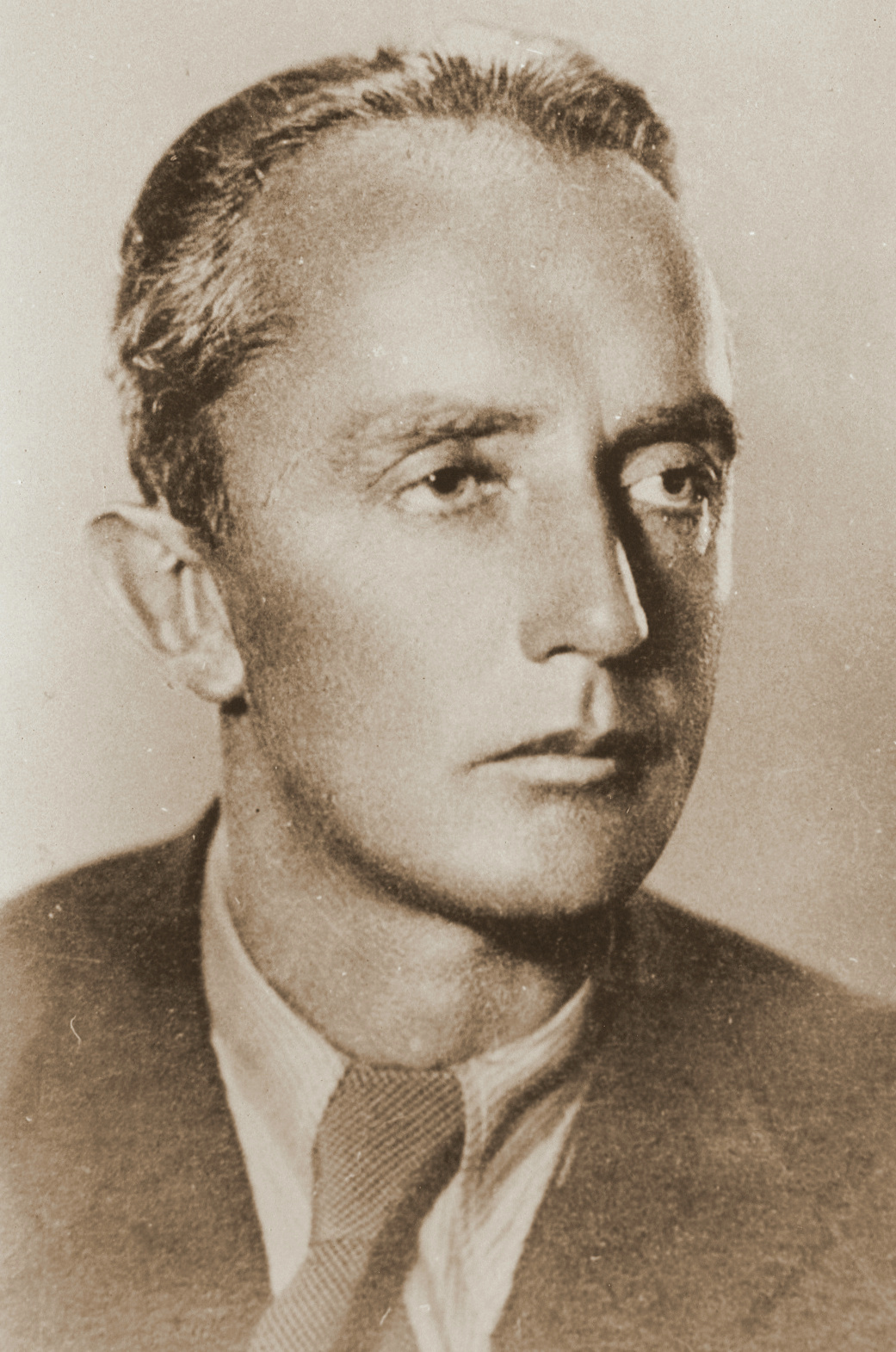 Albert Rejec, TIGR political leader.
Albert Rejec, TIGR political leader.
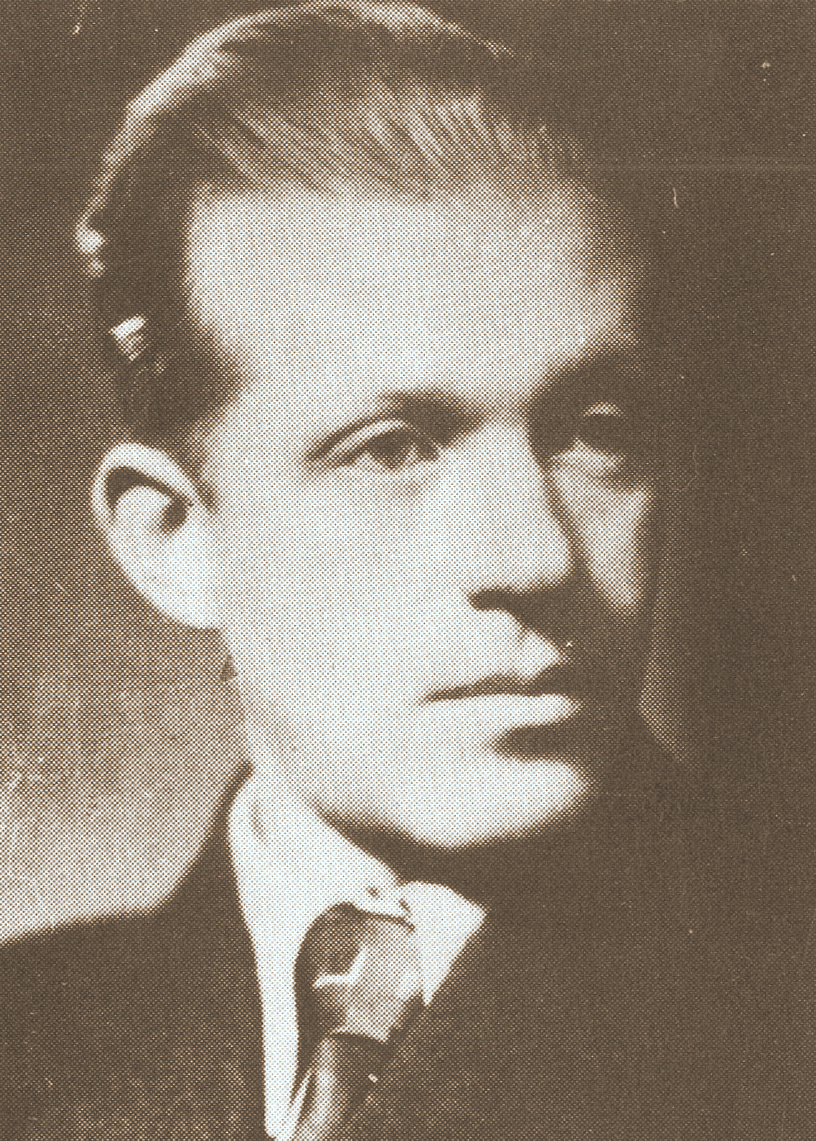 Danilo Zelen, TIGR military leader, killed in a skirmish with an Italian patrol in the Mala Gora hills on 13 May 1941.
Danilo Zelen, TIGR military leader, killed in a skirmish with an Italian patrol in the Mala Gora hills on 13 May 1941.
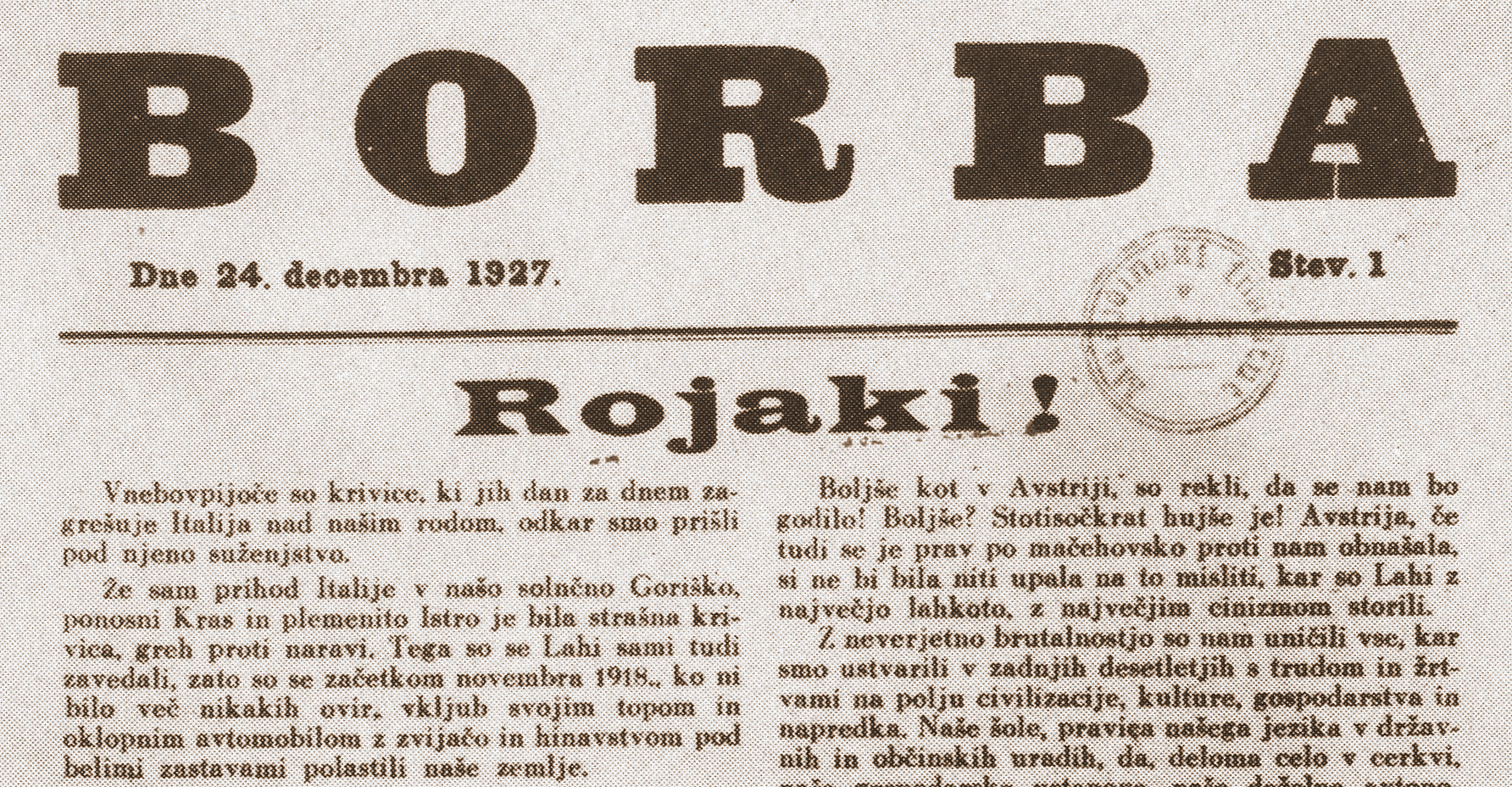 First issue of the Communist Party organ. It was published monthly under this name for about a year.
First issue of the Communist Party organ. It was published monthly under this name for about a year.
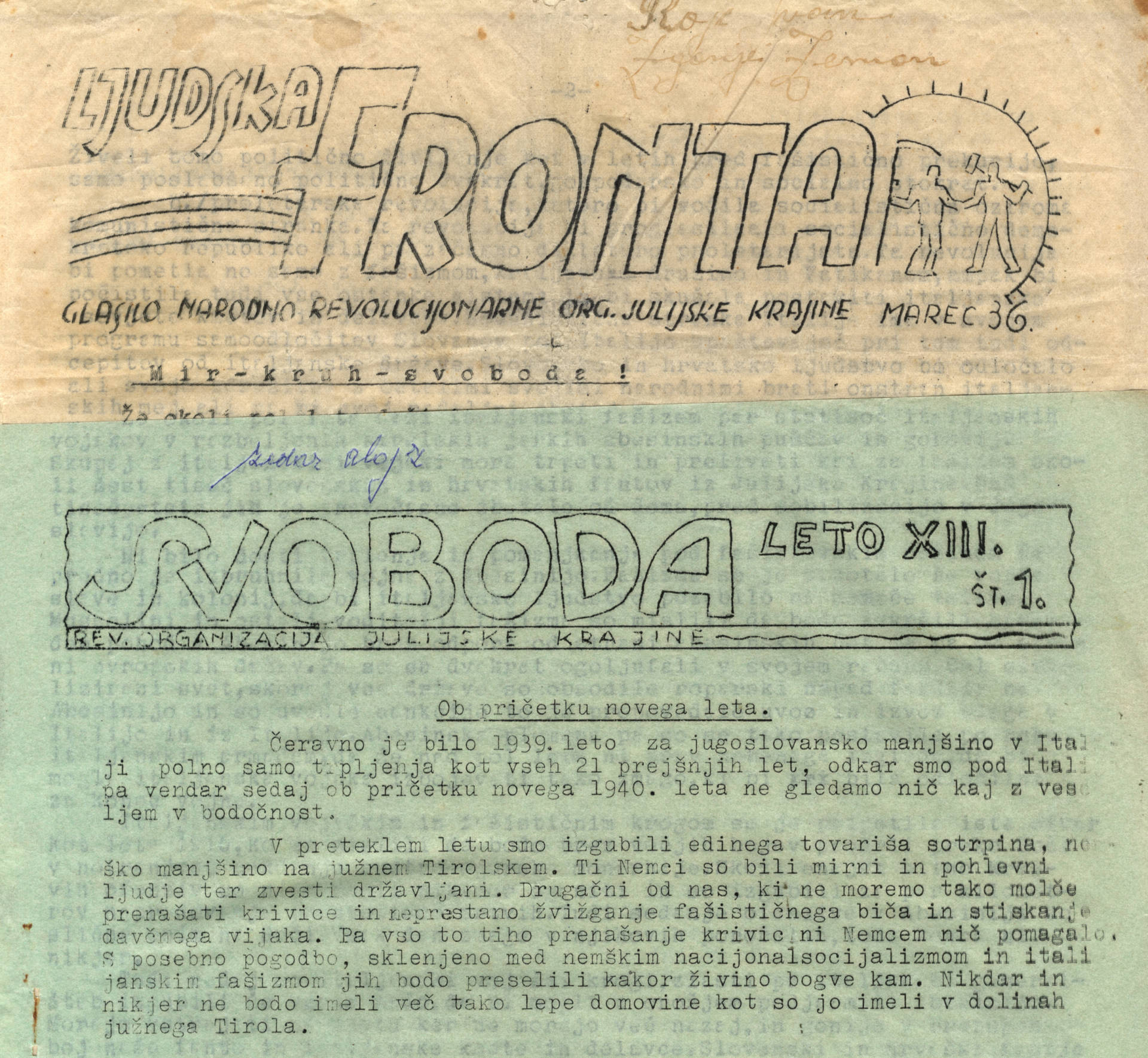 After 1929 it was renamed Svoboda (“Freedom”), and after 1935 Ljudska fronta (“Popular Front”). It was edited by Albert Rejec, initially in the Gorizia area and then in Ljubljana, where it was also printed.
After 1929 it was renamed Svoboda (“Freedom”), and after 1935 Ljudska fronta (“Popular Front”). It was edited by Albert Rejec, initially in the Gorizia area and then in Ljubljana, where it was also printed.
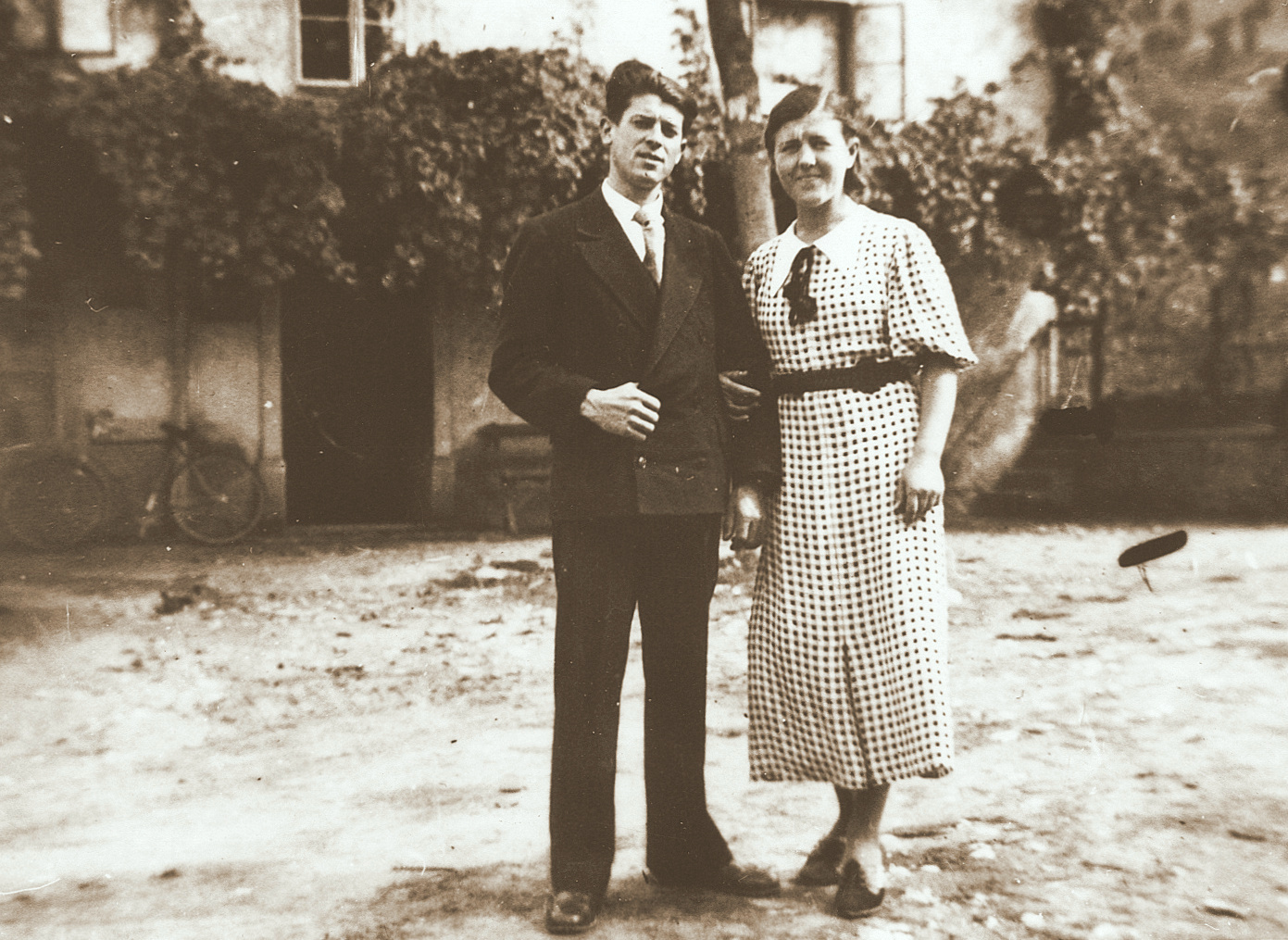 Viktor Bobek and Marija Urbančič, TIGR members from Ilirska Bistrica. Bobek was one of the leading Communists in this area up until 1932. He subsequently organised and led the Party organisation in the Ilirska Bistrica district. He was sentenced to death at the Second Trieste Trial and executed.
Viktor Bobek and Marija Urbančič, TIGR members from Ilirska Bistrica. Bobek was one of the leading Communists in this area up until 1932. He subsequently organised and led the Party organisation in the Ilirska Bistrica district. He was sentenced to death at the Second Trieste Trial and executed.
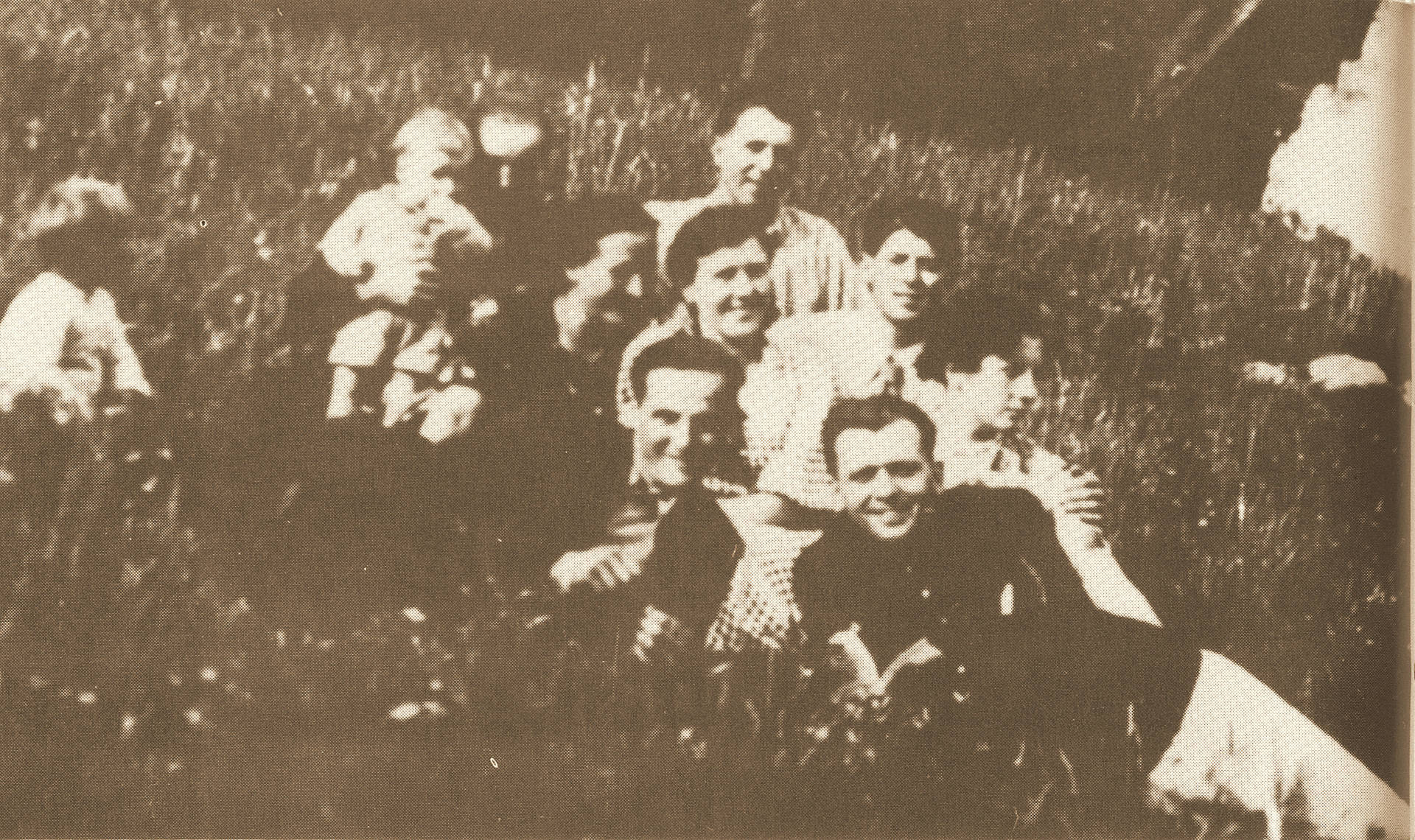 Ratečevo Brdo, 1937 – meeting of TIGR members from the surrounding localities.
Ratečevo Brdo, 1937 – meeting of TIGR members from the surrounding localities.
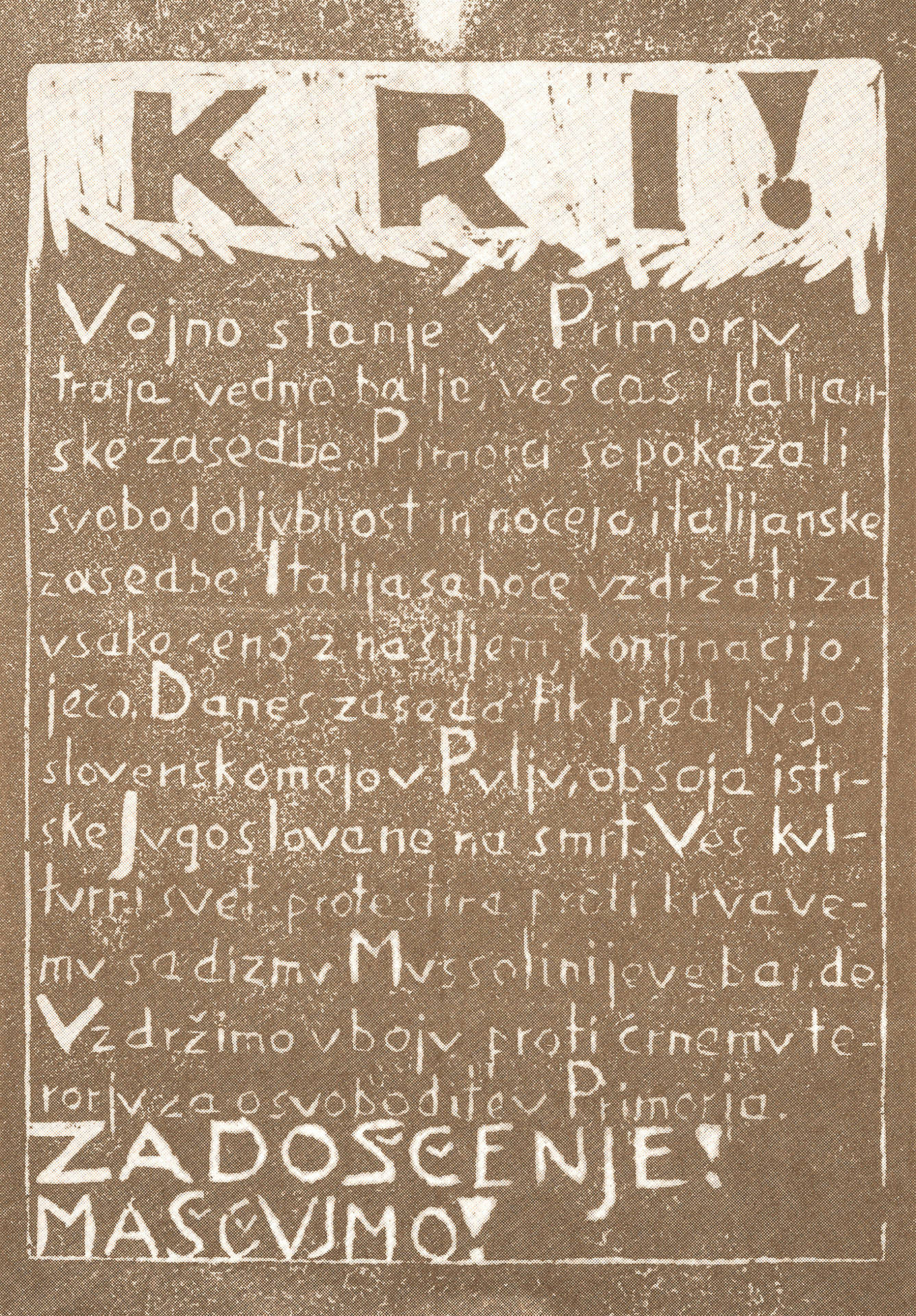 Flyer of the Borba organisation from 1929.
Flyer of the Borba organisation from 1929.
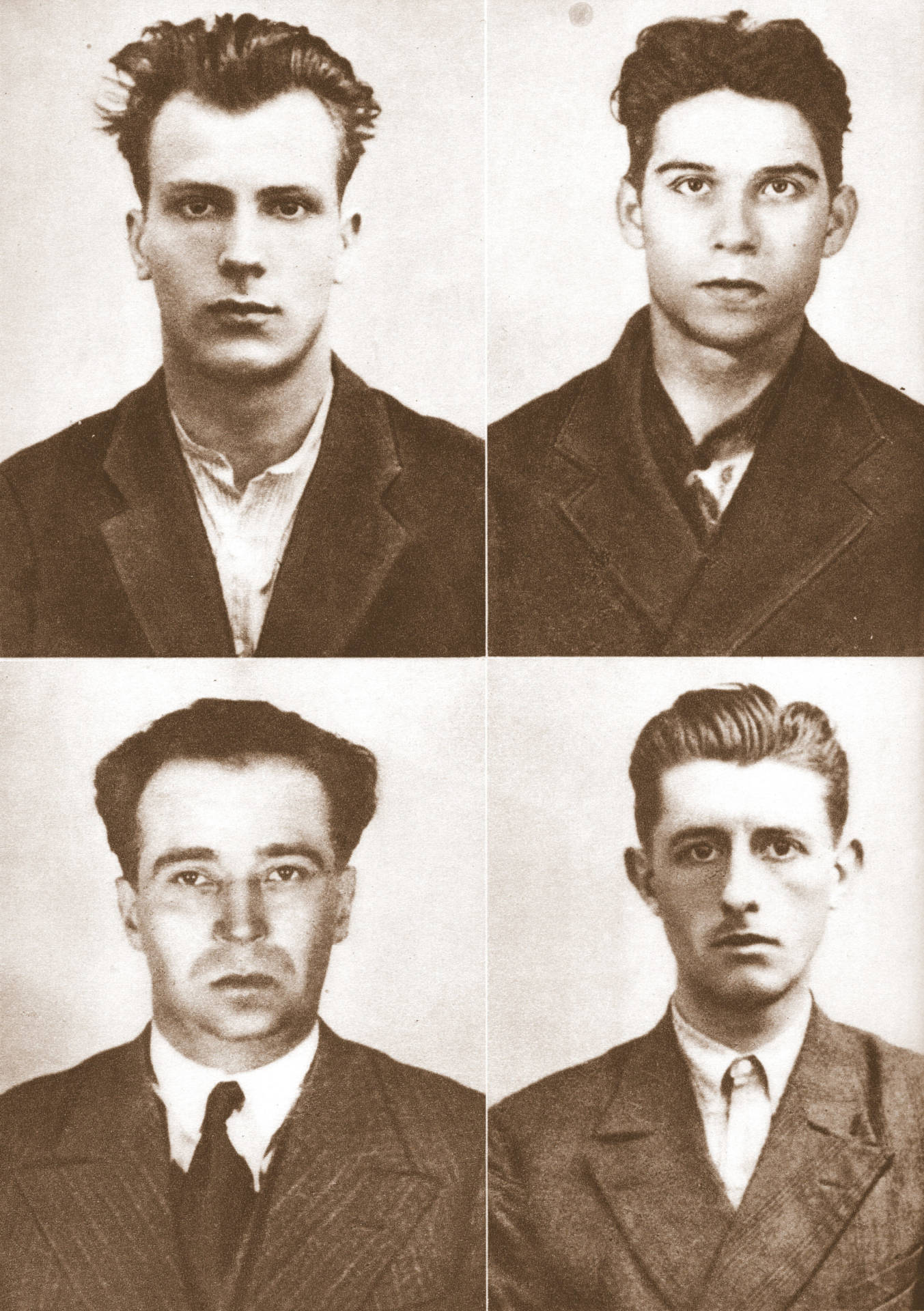 Leaders of the clandestine organisation Borba, sentenced to death and shot on 6 September 1930: Ferdo Bidovec, Franjo Marušič, Alojz Vadnjal and Zvonimir Miloš.
Leaders of the clandestine organisation Borba, sentenced to death and shot on 6 September 1930: Ferdo Bidovec, Franjo Marušič, Alojz Vadnjal and Zvonimir Miloš.
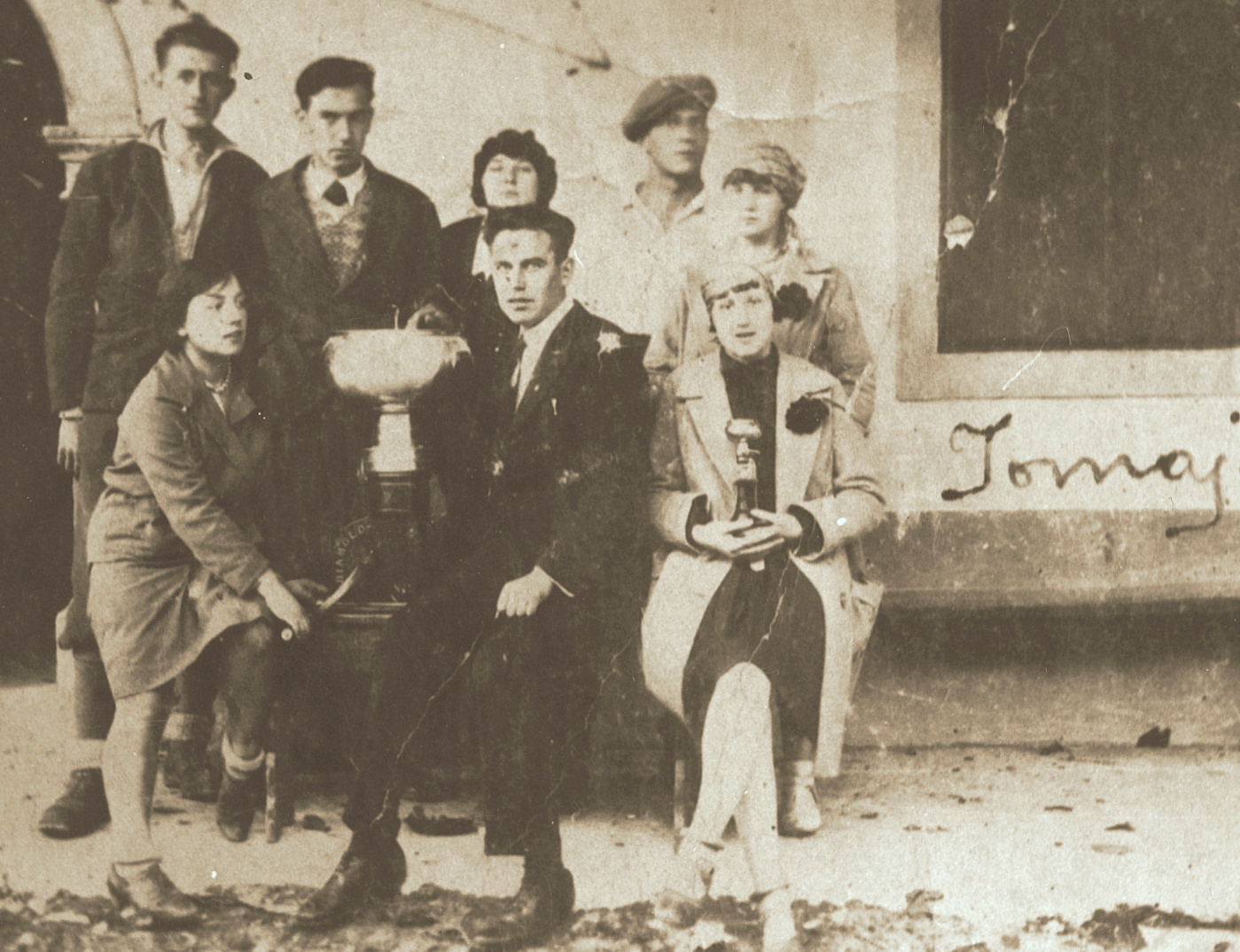 Young people from Trieste on an excursion to Povirje in 1928. Among them are Marušič, Bidovec and Miloš.
Young people from Trieste on an excursion to Povirje in 1928. Among them are Marušič, Bidovec and Miloš.
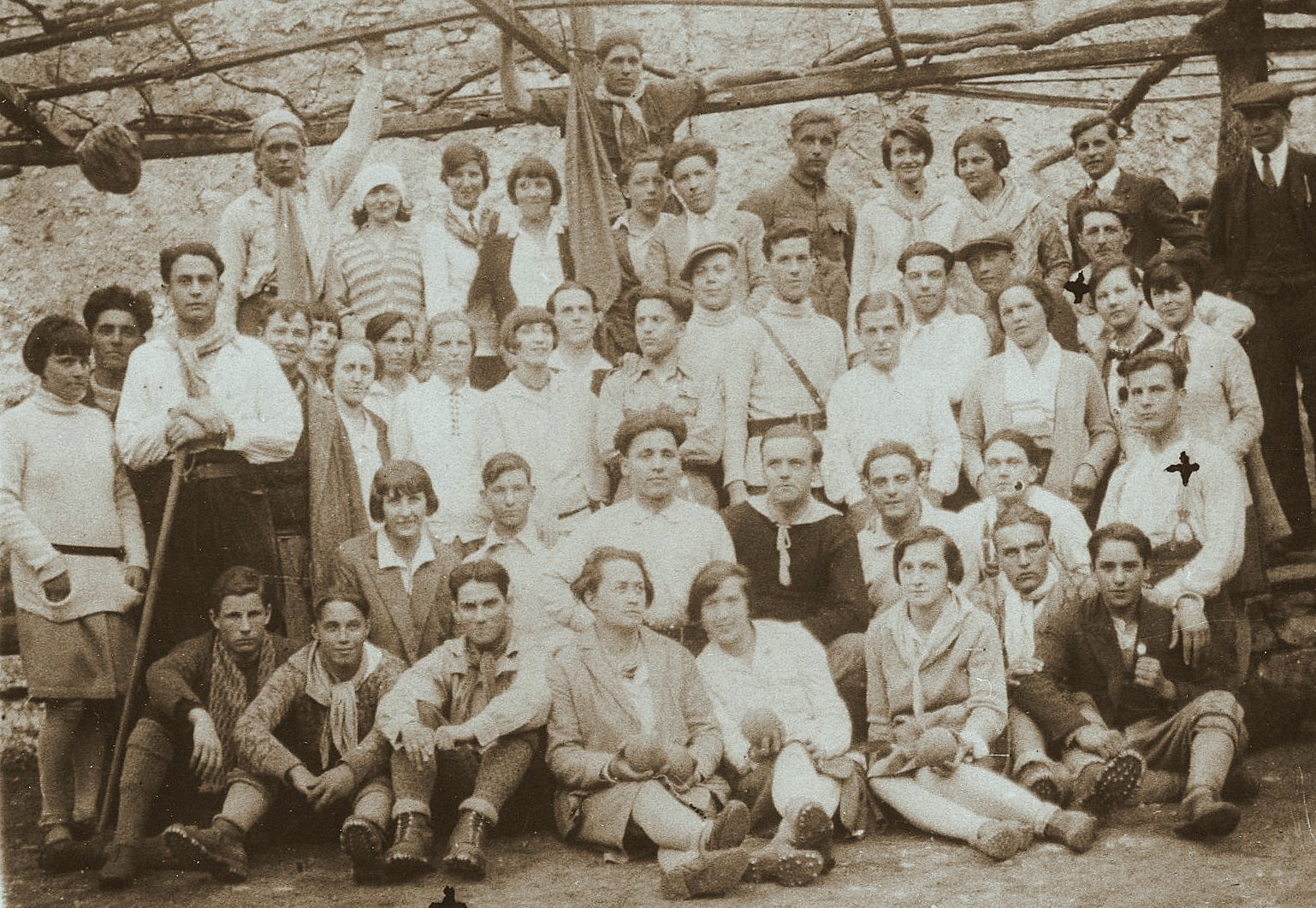 Tržaški mladinci na izletu v Tomaju leta 1929. To je bila še edina možna oblika združevanja, ki pa je dobila politično vsebino.
Tržaški mladinci na izletu v Tomaju leta 1929. To je bila še edina možna oblika združevanja, ki pa je dobila politično vsebino.